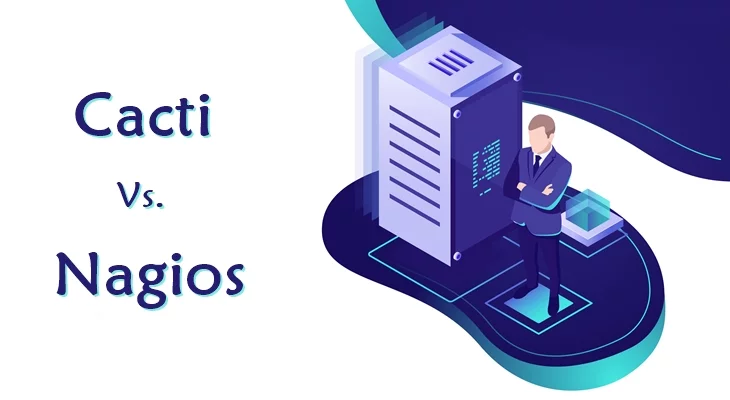Today, almost all of our systems depend on networks, be it intranet or the internet. For the smooth functioning of our systems, it is necessary to monitor the networks they function on. When talking about open-source monitoring solutions, Cacti and Nagios are two of the top contenders.
It is necessary to understand the solutions and the differences between them to know which one to opt for.
Nagios Core is an open-source IT-infrastructure monitoring solution.
Nagios monitors the servers, switches, and applications on the network. the system alerts the user in case of an issue and also when it is resolved.
It monitors the network and solutions for overloaded data links or connections, along with monitoring the switched and routers on the network. Also, It can scan and keep track of the uptime, availability, and response time of all the nodes in the system. It presents the data in graphical format as well as in reports.
Like Nagios, Cacti graphing and monitoring tool is also a web-based open-source network monitoring solution. It is the front-end tool developed for the data-logging tool RRDtool.
Cacti monitoring allows users to scan any device at predetermined intervals and then present the acquired in a graphical format.
It is most commonly used for monitoring network traffic by sampling the status of a network router with SNMP.
To understand the scope of each tool, let’s go through some of the differences between them:
When it comes to network monitoring, Nagios provides more features and functionality as compared to Cacti monitoring.
Cacti offers a limited number of network monitoring features. It is unable to detect a network link collapse. It also cannot navigate the network and hence is unable to create a network map.
Nagios supports Netflow, while Cacti does not.
Cacti can be integrated with Datadog and RRDtool. On the other hand, Nagios can be integrated with a number of tools such as Datadog, PagerDuty, Zulip, and PagerDuty, among many others.
Cacti is a pretty straight forward data logging and graphing tool. It has a decidedly old-school feel to its UI.
It is best used in industrial settings where data is required in graphical format or in the form of reports and presentations. Nagios has more of a modern feel to it.
Cacti can be used to monitor a network of hundreds of devices. However, it is not suitable to be implemented in a network with thousands of connected devices. Cacti is a good choice in cases when the network consists of a few nodes and servers.
On the other hand, Nagios claims to be capable of scaling up to an indefinite number of nodes. These nodes are any devices with an IP address.
Also Read: 14 Best Cloud Infrastructure Automation Tools
Plugins and out-of-the-box monitoring
Both Nagios and Cacti need a range of plugins to offer the complete range of services required from a network monitoring solution.
Nagios has a wide range of plugins available that contribute to improving the software’s functionality. Cacti, as compared, has a smaller catalog of plugins available. This makes Cacti incompatible with many business software.
In any network monitoring tool, an event is triggered reacting to the incident occurrence and on incident resolution. The events can include any issue in the existing system or when the system detects a new element in the system, etc.
Event management should include keeping a log of the events that have occurred. It should also include investigating the reason the event occurred in the first place.
Neither Nagios nor Cacti provide all the capabilities mentioned earlier. They neither provide incident resolution nor investigation in the happening of the event.
Nagios can detect network problems such as a broken link. It has an event history function. This means that it can record when an event has occurred.
As discussed earlier, Nagios provides the user with alerts whenever it detects a problem within the network. It also gives an alert once the problem is solved.
Cacti, on the other hand, collects data regarding any issues that arise. However, it does not provide the user with any alerts regarding the same.
Even though open-source, Nagios is not free. Meaning it must be paid for. However, it does come with a 12-month service contract.
It comes with two plans, the standard edition, and the enterprise edition. The standard edition starts from $1995, and the enterprise edition starts from $3495.
Cacti, on the other hand, does not cost the company any money. It is a free tool.
Being around since 2002, Nagios has a vast user community contributing to the product with custom APIs and scripts.
Cacti has a comparatively smaller user community and a repository of plugins and extensions. These plugins and extensions are not included in the original software and are maintained by the users themselves.
Conclusion
Cacti and Nagios are the preferred two among the experts and professionals alike from all the available network monitoring tools available. Hence, it is a no brainer for organizations looking for a network monitoring tool to opt for any one among the two.
There are other tools available in the market, but they do not match the features provided by these two tools. If you are an SME and have a small network set up with a small number of servers, it would be recommended to opt for Cacti. Large enterprises can also opt for Cacti, but it would be recommended to opt for Nagios.
You May Also like to Read:
5 Network Tools for Windows that you need to know & Implement





